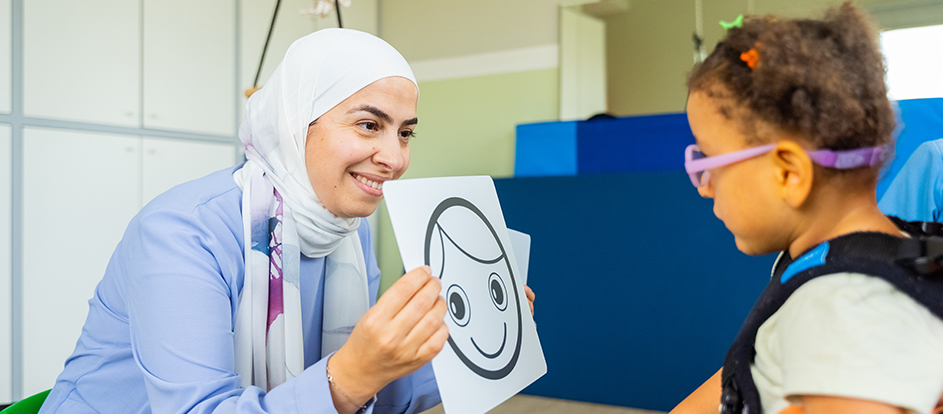Why is vision important in children?
According to research, 80% of what children learn is through their eyes. Research also shows that up to 80% of the sensory information that arrives to the brain is derived from the visual system. The vision serves as a valuable gateway to understanding and experiencing the world around them. Additionally, vision guides other learning experiences. Uncorrected or detected vision problems may affect children’s ability to learn and reach their highest potential and cause developmental delays. Similar to how babies learn to walk and talk, their visual abilities develop gradually over time. At birth, they do not possess all the necessary visual skills required. Infants have clear vision for objects that are approximately 20 to 25 centimeters away from their faces. At around 3 to 4 months, a baby’s eyesight starts to improve. In the following years, children gradually develop the capability to see objects at greater distances, accurately assess distances, and enhance eye-body and eye-hand coordination. They learn to focus their eyes, move them accurately, and coordinate their vision. Additionally, they acquire the ability to process the visual information transmitted to their brain to comprehend the world and engage with it appropriately.
Early detection of any issues is crucial to ensure that babies have the chance to develop the visual abilities necessary for their growth and learning. Parents have a significant role in ensuring that their child’s eyes and vision develop properly.
According to the American Public Health Association, about 10% of preschoolers have eye or vision problems. However, children this age generally will not voice complaints about their eyes.
Children with disabilities are at a much higher risk of having visual impairment than those without disabilities (10.5% vs 0.16%) and are also at higher risk of developing ocular problems such as strabismus and refractive error. This increased prevalence of visual impairments and problems in children with disability can be attributed, in part, to brain injuries such as pre-natal asphyxia or prematurity, which often underlie various disabilities, including learning disabilities and sensory impairments. Children with disabilities may experience various types of vision problems, including
- Strabismus (eye turns)
- Accommodation (Eye focusing for near)
- Amblyopia (Lazy eye)
- Oculomotor functions such as following, scanning and saccade movement.
- Binocular coordination (stereo vision)
- Depth perception
- Cortical visual Impairment
Visual problems in young children can be divided into two major types: 1) ocular visual impairment which involves disturbance in the eye structure (underdeveloped or damaged) due to disease or infection and 2) cortical visual impairment (CVI) where the damage is in the brain (the visual information received from the eyes can’t be interpreted). Children can have one type of visual impairment or both (Newcomb, 2009). Children with visual impairment due to the brain damage are more likely to have other disabilities because of the involvement of central nervous system than those who are visual impaired due to eye problems.
What is Childhood Low vision?
Childhood low vision pertains to impaired vision in individuals under the age of 21 that cannot be corrected through medical interventions, surgical procedures, or regular eyeglasses. Low vision in children can manifest from birth (congenital) or occur because of vision loss during childhood. The causes of vision loss can range from diseases affecting the eye to damage in the visual areas of the brain. Low vision in children may go undetected as the symptoms can be mistakenly attributed to other physical or genetic conditions. If a child’s development is atypical, it is crucial for parents or guardians to seek the expertise of an ophthalmologist specialized in assessing and treating children’s vision. Regular medical eye exams by an ophthalmologist are important to diagnose eye diseases early. It is important to identify conditions that are treatable such as refractive errors.
What is Cortical Visual Impairment (CVI)?
According to Perkins School for the Blind CVI, “CVI is a brain-based visual impairment caused by damage to the visual pathways or visual processing areas of the brain.”
There are 10 characteristics associated with CVI and each will look different depending on where the individual’s visual processing falls on a range of visual functioning.
- Color preferences (often red, yellow, saturated)
- Need for movement (to elicit/sustain attention)
- Visual latency (processing time)
- Visual field preferences
- Difficulty with visual complexity (array, target/object, multisensory, faces)
- Need for/attraction to light
- Difficulty with distance viewing
- Atypical visual reflexes (blink to touch, blink to threat)
- Difficulty with visual novelty (easier with familiar objects, people, settings)
- Difficulty with visually guided reach (looking and reaching/touching at the same time)
How is it different from other visual impairments?
Individuals with CVI often have healthy eyes and obtain normal results on an eye exam, because it is the processing of vision in the brain that is atypical. CVI does not have an impact on visual acuity, contrast sensitivity, or many of the other symptoms of ocular visual impairments. CVI cannot be corrected with glasses.
Children and youth with CVI can be expected to make progress in their visual functioning over time if provided with appropriate assessment and intervention. CVI requires a very different approach to instructional supports and environmental/material adaptations as compared with ocular visual impairments.
What should you expect during a vision assessment for your child?
A comprehensive assessment of children with special needs usually requires a developmental and functional vision evaluation. Ophthalmology detects ocular issues that cause reduced vision such as optic nerve atrophy or refractive errors and he prescribes the corrective glasses. Early identification of vision conditions is essential for treatment to be successful. Visiting an ophthalmologist is a crucial step to ensure that your child has no ocular issues. Nevertheless, when it comes to children with additional challenges, relying solely on traditional vision testing may not be sufficient. It is crucial to go beyond standard assessments and conduct functional vision assessments. This is because parents may observe that their child’s visual function is not within the normal range, even if the ophthalmologist’s results appear normal or fail to explain the observed visual impairments or behavioral changes. Functional vision assessments provide a more comprehensive understanding of a child’s visual abilities, considering their specific challenges and behaviors. By evaluating how a child uses their vision in daily activities and observing their visual responses, functional vision assessments can help uncover underlying issues and guide appropriate interventions to support their visual development and function.
At High Hopes, we prioritize the comprehensive assessment of children with low vision and CVI by offering specialized functional vision assessments. Our team utilizes a range of specialized tools and techniques tailored to each child’s unique needs. These assessments go beyond traditional measures, focusing on evaluating how the child utilizes their vision in practical everyday tasks. We employ specific tools and methods designed to assess visual skills including visual tracking, visual attention, visual perception, and visual-motor integration. By conducting these functional vision assessments, we aim to gain a deeper understanding of a child’s visual abilities and challenges, enabling us to develop targeted interventions and support strategies to maximize their visual potential and enhance their overall development and independence.
How can your child benefit from vision assessment and therapy?
Vision assessment and therapy can provide numerous benefits for a child’s overall visual health and development. Here are several ways in which your child can benefit from vision assessment and therapy:
- Early Detection of vision problems and issues: Vision assessments can identify vision problems or abnormalities at an early stage. Detecting issues such as refractive errors (e.g., myopia and hyperopia) and amblyopia (lazy eye) can help initiate timely interventions.
- Vision assessment can provide valuable insights into a child’s level of visual function which can guide the development of appropriate accommodations and adaptations in various therapy sessions and at home.
- Individualized Treatment Plans: A comprehensive vision assessment can determine the specific visual challenges a child may be facing and if is it related to ocular problem or CVI and in which phase in the CVI scale. Such information can be used to create personalized treatment plans that target the child’s specific needs and goals. For example, if the assessment reveals that the child has CVI, therapy sessions can include CVI strategies to improve visual functioning.
- Customized Accommodations: Based on the results of the functional vision assessment, recommendations can be made for appropriate accommodations to support the child’s visual needs. This can include modifications in the classroom environment, such as seating arrangements and lighting adjustments.
- Home-Based Strategies: Vision assessment outcomes can inform parents and caregivers about the specific visual challenges their child is facing. This knowledge enables them to implement targeted strategies at home to support the child’s visual development. These strategies could be implemented at mealtime or storytime.
- Support multidisciplinary approach: At High Hopes, we share the assessment finding with other therapists such as occupational therapists or speech therapists. This collaboration ensures a holistic approach to addressing the child’s needs and allows therapists to incorporate visual strategies and considerations into their respective interventions.
If your child has special needs and exhibits behaviors that may be related to a vision condition, schedule a comprehensive eye exam of both low vision and visual functioning by reaching out to us.





